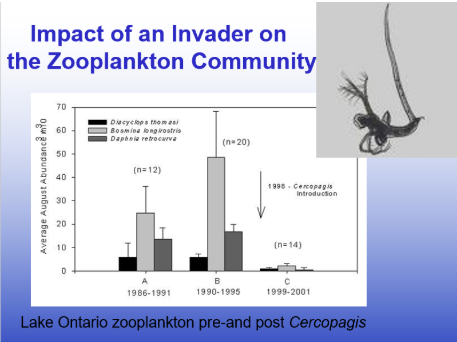PP 8: Zooplankton community dynamics
1/29
There's no tags or description
Looks like no tags are added yet.
Name | Mastery | Learn | Test | Matching | Spaced |
|---|
No study sessions yet.
30 Terms
seasonal succession graph
Generalization
Copepods, have a higher percentage of predatory species
Predators: 15% of the population
This is why copepods have that steady presence, and also because they live longer than the other species
Rotifers and cladocerans have those peaks, have low winter density
Rotifers peak in the spring, cladocerans peak in the fall
Respond to the seasonality of phytoplankton
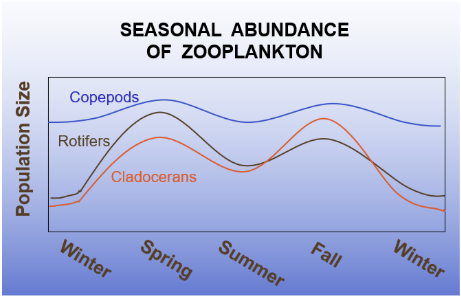
Community ecology: seasonal succession
pic
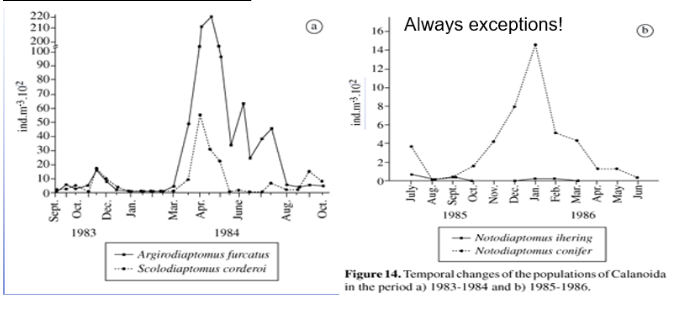
Community ecology: resource partitioning
-Habitat partitioning in Polyarthra species, Lake Skarshult
Closely related species may populate different areas of a lake
They need to separate themselves so they can get ahold of the nutrients they need
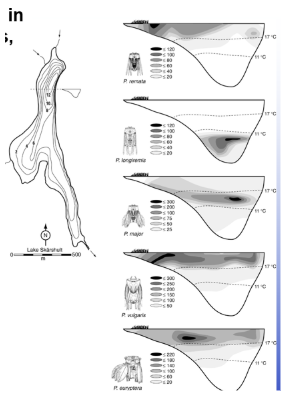
Feeding and assimilation rates: filter feeding rate
-1. terms of expression
Feeding rate
Count the number of algae cells per time, etc. How many cells of algae is it eating per hour
Filtering rate
Instead of counting cells, you’re taking a volume of water and then letting them filter the water
number of liters of water filtered per animal per day
-2. Methods of measurement
Direct counting method
Count algal cells at beginning (t0) and end (tn) of feeding period; calculate # cells removed per L per h
Radioisotope method
Label algae (or other food, e.g. yeast) with 32P or 14C
Incubate known algal quantity with zooplankton in chamber
Collect and radioassay zooplankton (can separate by species)
Feeding and assimilation rates: assimilation rate (non-assimilated food in defecation)
-Respiration
Measured with O2 probe
-Defecation
Collect defecation and combust it and get a calorie count
-Radioisotope method
Label food, feed it to them, once the gut clears whats left inside the body is the radioisotope signature
population dynamics for a given species
-Population growth rate: r
b= birth rate
d= death rate
e= emigration rate
i= immigration rate
-r=b-d-e+i
population dynamics: controlling factors
Birth rate
Zooplankton are temp dependent. With a high temp, molting will speed up, this speeds up birth rates.
Increased food supply = increased number of offspring, increased brood size
death rate
Predation can be major, the big driving factor of population of zooplankton
Longevity is greater at lower temps
Growth rate slows down, but more likely to live longer
Emigration
Depends on your system
Common with outflow systems
Depends on stream discharge lake relative to lake volume
Ex. Dam being open or closed
immigration
Stream coming into a lake
Invasive species, things hitch rides on boats
Birds/mammals can transport things
population dynamics: practical quantification
-Instantaneous growth rate:
In most lakes, immigration and emigration are negligible
If birth rate is relatively rapid, then over short periods death rate is negligible
Therefore, birth rate alone is often used as an estimate of “instantaneous growth rate”: r=b
birth rate is a function of:
-# of adults in the total population (population is one species, multiple species would be a community)
-Average brood size (# of eggs per female)
-Egg development time
b=logn [1 + (#adults/pop size x average brood size/egg dev time)]
The egg ratio method was pioneered by W.T. Edmonson
Measured in a lab, extrapolated into the field
-graph note: if there’s no predators theres usually an exponential growth curve
![<p class="Paragraph SCXW174507106 BCX0" style="text-align: left;"><span style="line-height: 20.925px;">-# of adults in the total population (population is one species, multiple species would be a community) </span></p><p class="Paragraph SCXW174507106 BCX0" style="text-align: left;"><span style="line-height: 20.925px;">-Average brood size (# of eggs per female) </span></p><p class="Paragraph SCXW174507106 BCX0" style="text-align: left;"><span style="line-height: 20.925px;"> </span></p><p class="Paragraph SCXW174507106 BCX0" style="text-align: left;"><span style="line-height: 20.925px;">-Egg development time </span></p><ul><li><p class="Paragraph SCXW174507106 BCX0" style="text-align: left;"><span style="line-height: 20.925px;">b=log<sub>n</sub> [1 + (#adults/pop size x average brood size/egg dev time)] </span></p></li></ul><ul><li><p class="Paragraph SCXW174507106 BCX0" style="text-align: left;"><span style="line-height: 20.925px;">The egg ratio method was pioneered by W.T. Edmonson </span></p></li></ul><ul><li><p class="Paragraph SCXW174507106 BCX0" style="text-align: left;"><span style="line-height: 20.925px;">Measured in a lab, extrapolated into the field </span></p></li></ul><p>-graph note: if there’s no predators theres usually an exponential growth curve</p>](https://knowt-user-attachments.s3.amazonaws.com/7ce3db8e-9585-48ac-a90b-e00d5bc2d824.png)
Don Hall’s surprise
Because these are such predatorial systems, death is in fact an important factor
So things that had ignored death were not true
Top one is a generalized pattern of population dynamics
Bottom graph, something besides food is controlling the daphnia population because it deviates from the generalized pattern.
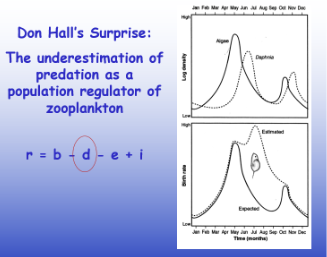
Size selective predation on zooplankton
-Planktivorous fish are size selective
Visual predators
This impacts zooplankton species structure
Fish can only eat things that fit in their gape size (mouth size)
They're going to eat the biggest thing they possibly can
With secondary effects on phytoplankton grazing results
-Classic size selection experiments of Brooks and Dodson:
When fish were introduced to previously fishless lakes, they strongly reduced all zooplankton species greater than 1mm in size
Smaller zooplankton species become more dominant
Community composition changed
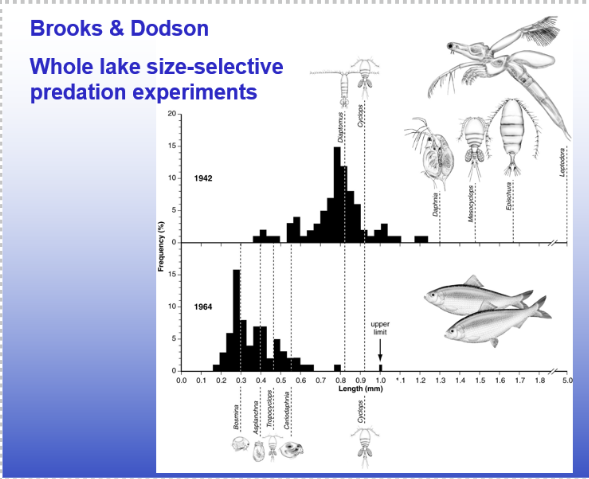
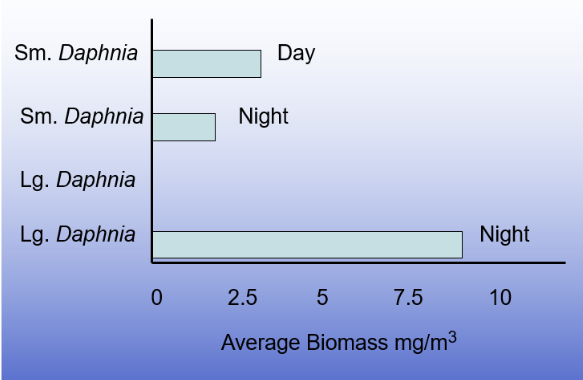
size in the water column graph
Zooplankton move up and down in the water column. In the day they move down, at night they move up
The biggest ones come out at night. They hide in the day from the fish
Small ones come out during the day
Fish predation on zooplankton
pic
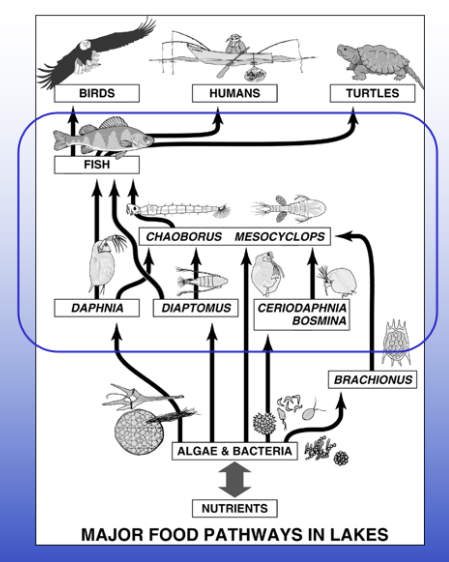
Alewife (herring): a size-selective predator
What can pass past the gill rakers is what they’re eating
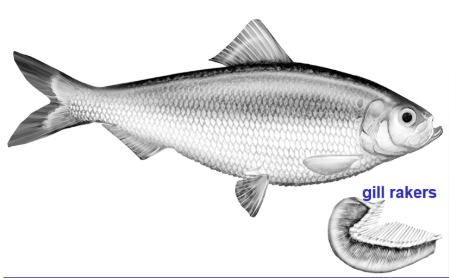
Trophic cascase
Idea of something at top driving whats below it, top down control
Piscivorous fish= fish eating fish
Planktivorous fish= fish eating plankton
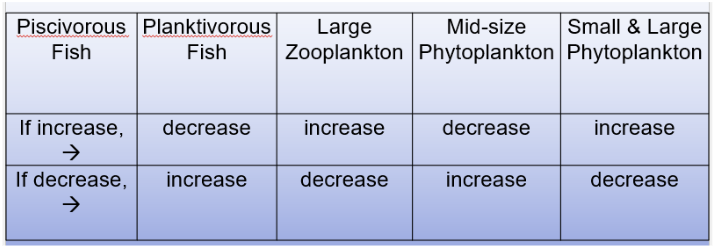
Top down control
Some argue system is controlled by the nutrients, not by the predators
It can be both
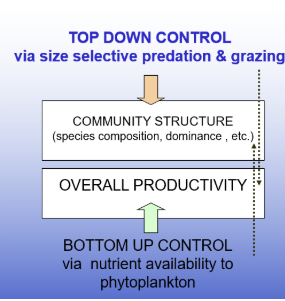
top down trophic cascade
pic
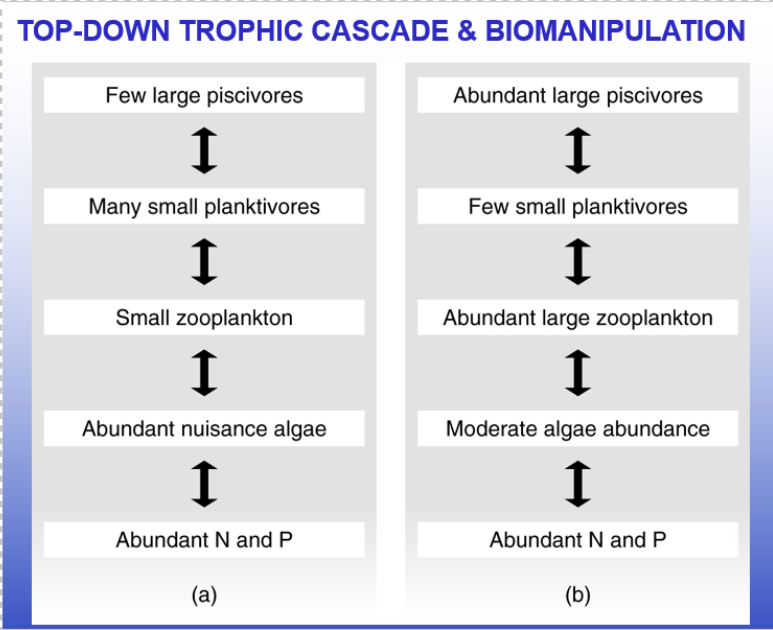
evolutionary question
-Why should large species dominate a zooplankton community in absence of fish predation?
-Advantages of relatively large body size in zooplankton:
Greater range of food availability and feeding efficiency- with larger filtering apparatus, both small and large algae etc. are consumable
Lower respiration rate
Lower surface area to mass ratio
Larger brood size
If she can carry more babies, she might still have an edge even if predation is high for her because of her body size
Probably the most important factor
relative competition fitness vs predation avoidance fitness
pic
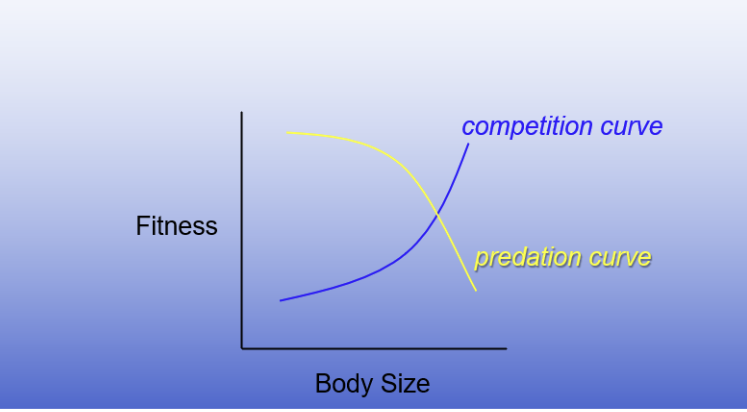
vertical migration of zooplankton
Most zooplankton species exhibit cyclic vertical migration in the water column, generally associated with day/night cycles. The largest species migrate the most
Largest species can also move faster and better in the water column
Primarily the cladocerans and copepods in freshwater
Distances: several meters per day
Velocities: up to nearly 2 cm per sec (= approx. 1 meter per min). This is a very energy intense behavior, and therefore must have resulted from major evolutionary selection pressures
vertical migration of zooplankton: migration patterns
-Nocturnal
Up a night, down during the day
Most common
-Twilight
Up a dawn and dusk, down during day at night
-Diurnal
Down at night, up during the day
Most rare
Smaller species, less predation prone
vertical migration of zooplankton: controllers for nocturnal type
-Primarily a combination of
Negative geotaxis
Movement away from gravity
Negative phototaxis
Movement away from light
-Phototaxis controllers
Principally blue light (they are red blind)
Rate of change in light -> initiation and velocity
How quick the light changes will drive the speed
Maximum intensity -> depth of migration (but will not descend into anaerobic hypolimnion)
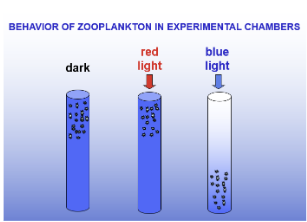
Hypotheses for evolutionary (and other) significance of vertical migration
-1. sampler avoidance: (in light)
When you throw a net, they can swim away
-2. predator avoidance
Natural tendency for light avoidance in predator vulnerable species
Probably the best theory
-3. feeding efficiency- McLaren hypothesis
Feeding is more efficient at high temp
Growing is more efficient at low temp (low resp.)
-4. food quality- Haney hypothesis
Phytoplankton make more protein and divide faster at night -
Vertical migration of zooplankton Cont.
-General practical implication of nocturnal migration: daytime sampling of zooplankton in the epilimnion (especially near surface) only will greatly underestimate population sizes. Also, there can be major horizontal patchiness in distribution:
Zooplankton are concentrated by (and attracted to) Langmuir convergence zones
Lots of zooplankton in the slick
If you sample in the downwelling outside the slick, there will be less zooplankton
There is avoidance of the littoral zone in some (predator avoidance?)
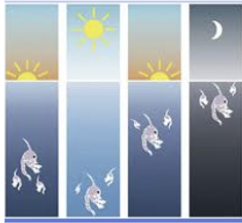
Vertical migration of zooplankton graph
See different patterns bc theres different species
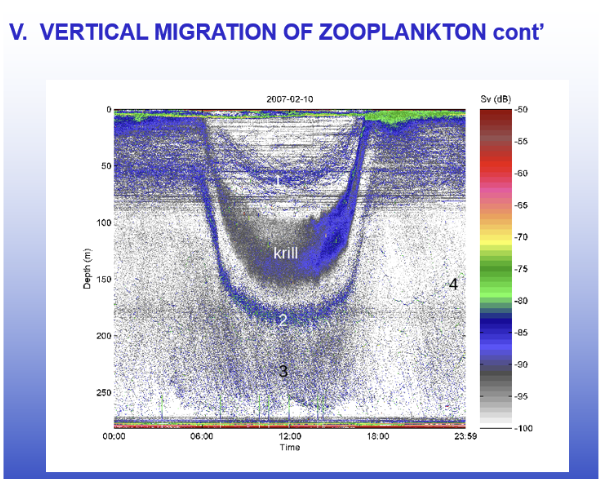
vertical migration graph
pic
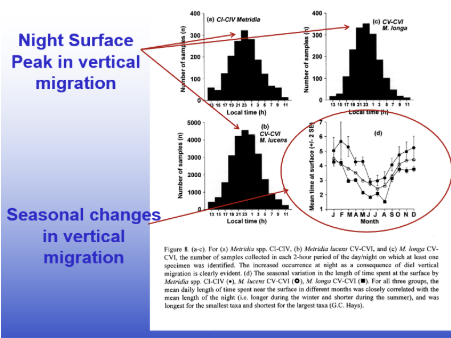
seasonal changes in vertical migration
-Algae is somewhat predictable, zooplankton are much more complex
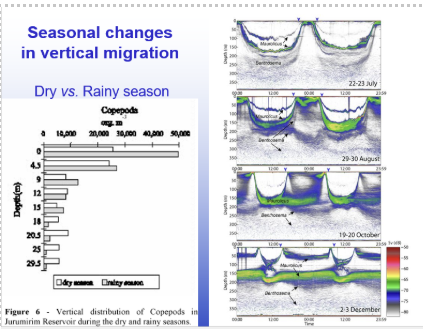
endogenous rhythm of migration behavior
Still moving up and down without “seeing” light a day
Are genetically programmed to still move
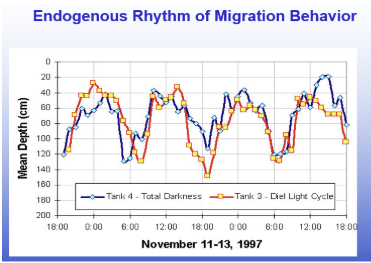
response to predator exudates
Theres a big change in behavior once you add fish juice. Shows there's a predatory response
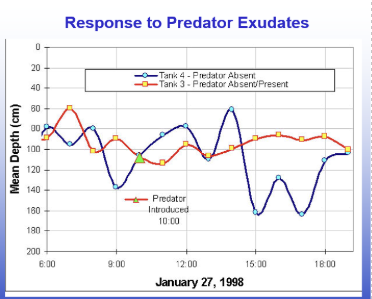
impact of an invader on the zooplankton community
Predator introduced, zooplankton drops down
